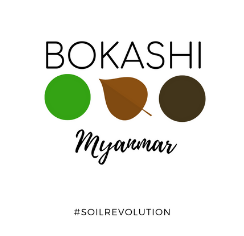If you live in an apartment and don’t have a balcony, you can make what we call a “soil factory” – basically a rice tub where you mix old soil and bokashi to make a steady supply of new soil.
What happens is that the soil microbes in the soil/compost/cow manure interact with the bokashi microbes in the fermented food waste. Your food waste will be converted into soil thanks to the good work of the microbes.
The process can take anything from one to eight weeks, depending on how you go about it.
Worried about having too much soil? Not an issue. Give it to friends, or donate it to a community group. And please some under all the valuable trees in your neighbourhood!
What do I need to get started?
You will need a plastic rice tub or similar, a bag of compost, soil or cow manure, and a container of fermented kitchen bokashi. This is just to get started, after the first time you can reuse the same soil to process your bokashi.
How do I do it?
- Find a good spot for your soil factory. It can be indoors or outdoors, but should be protected from the rain.
- Put half of the soil, compost, or cow manure into the rice tub. Make sure there are no plastic scraps in it.
- Empty your container of bokashi food waste into the soil.
- Mix it well with the soil/compost, and break up any large pieces of fruit or vegetables. Again – no plastic.
- Cover with the remaining soil/compost. The top layer should be at least 5cm thick, preferably more.
- Check after a week or two. You should find most of the bokashi has been absorbed into the soil, or is well on its way. If it takes longer, it is generally because the pieces are on the large side, they have not been well-mixed with the soil, or the soil or sand you used as a starter is of low quality.
- You can add another container of food waste whenever you like. Remove some of the previous soil, add the bokashi, then top with the soil again.
- Use the soil as needed for your plants, or to give away to others.
- Continue this process as long as you like!
How strong is the bokashi soil?
This depends on what you have mixed into it.
If you keep adding bokashi to the same soil mix you will end up with a very concentrated fertiliser. Use it sparingly!
You can also add a handful of this bokashi fertiliser to your watering can, leave it to soak for a day, and use it as a liquid fertiliser.
If you want a weaker soil to use as potting mix rather than fertiliser, you will need to dilute it with lower-grade soil, sand or other materials. The same applies if you want to produce a larger quantity of compost as a mulch for existing pot plants.
Suggestions for increasing the volume of your soil factory:
- dry leaves, preferably shredded
- shredded newspaper or office paper
- torn-up egg cartons or brown cardboard
- sand or poor soil
- nursery potting mix made from sand and ash
- discarded pot plants (disease-free)
- coconut fiber
- sugar cane fibers from juice stands
- grass cuttings in small volumes
Experiment with different methods, but the basic concept is that you can very easily process your family’s food waste in a rice tub on your balcony or in your stairwell. It will only take a few minutes per week, and you’ll most likely be amazed with the results.
The days of carrying trash down the stairs to dispose of it are over — you can recycle your own food waste in your apartment. Instead of waste you can now create soil!
